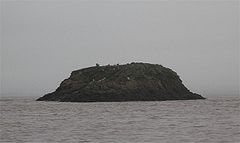Denny Island
 | |
 | |
| Geography | |
|---|---|
| Location | Severn Estuary |
| Coordinates | 51°31′33″N 2°46′51″W / 51.52578°N 2.78091°W |
| Area | 2,400 m2 (26,000 sq ft) |
| Administration | |
Wales | |
| County Council | Monmouthshire |
| Demographics | |
| Population | 0 |
Denny Island (Welsh: Ynys Denny) (grid reference ST459810) is a small rocky island of 0.24 hectares (0.6 acres), with scrub vegetation, in the Severn Estuary. Its rocky southern foreshore marks the boundary between England and Wales. Above high water mark, the island is reckoned administratively to Monmouthshire, South Wales. The island also marks the north-western limit of the City of Bristol's water boundary in the Severn estuary.[1]
It is located approximately three miles north of Portishead, midway between Redwick in Wales and Avonmouth in England. It is surrounded by sandbanks known as the Welsh Grounds. Its foreshore area changes dramatically according to the state of the tide, because tides in the estuary and Bristol Channel are amongst the highest in the world, reaching 13.7 m (45 ft) at the spring equinox. It is known as a nesting-place for gulls, cormorants and other seabirds, which are regularly seen and ringed there.
History
Denny Island appears in the historical record for the first time as Dunye, in the charter recording the creation of the county of Bristol in 1373.[2] This suggests that the name means, in Old English, 'island shaped like a down (i.e. a hill with a rounded profile)'. It gives its name to the Denny Island Fault Zone, a part of the Avon-Solent Fracture zone.[3]
In 2004, the island was subject to an unsuccessful appeal under Section 6(1) of the Countryside and Rights of Way Act 2000 against it appearing on a map of registered common land.[4]
References
- ^ "Bristol City Council - Beating Bristol's water boundary". Archived from the original on 12 October 2007. Retrieved 10 March 2009.
- ^ Harding, N. Dermott (1930). Bristol charters, 1155-1373 p 154-5. Bristol Record Society.
- ^ Kellaway, G.A. (1996). "Discovery of the Avon-Solent Fracture Zone and its relationship to Bath hot springs". Environmental Geology. 28 (1): 34–9. doi:10.1007/s002540050076.
- ^ "Appeal Decision" (PDF). Planning Inspectorate. November 2004. Archived from the original (PDF) on 13 December 2007. Retrieved 21 May 2007.
External links
